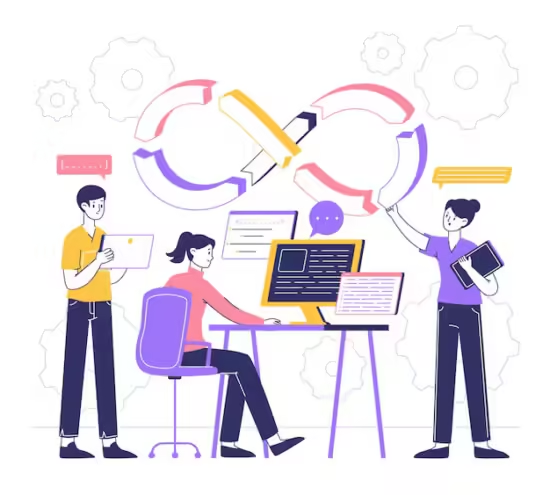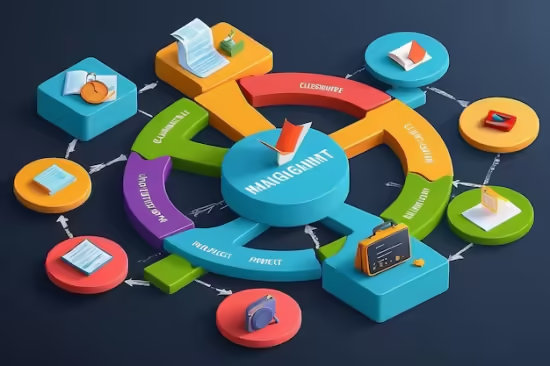What is the Software Development Life Cycle? – The Software Development Life Cycle (SDLC) is a process that provides a structured approach to software development. It is a methodology developers, engineers, and project managers use to ensure the creation of high-quality software systems that meet client expectations and operate efficiently.
The SDLC outlines a sequence of phases that guide a software project from its initial concept to its final delivery and ongoing maintenance. At its core, SDLC ensures systematic software development. This process helps teams focus on project goals while managing costs, meeting timelines, and mitigating risk.
Understanding the client’s needs is essential in any software project, which is why the SDLC begins with requirements planning and analysis. Once the project goals are well defined, the system design phase establishes how the software will work and creates a foundation for developers to follow as they build the application.
Writing the code is where most of the work happens, but the SDLC doesn’t stop there. Software testing is equally important because this phase ensures that the product works as it should and is free of critical bugs. After successful testing, the software is deployed in the intended environment and made available for use.
The SDLC also emphasizes the importance of ongoing maintenance. Software is not static; it must evolve to meet new user needs, resolve bugs, and adapt to changes in the technological environment. Each SDLC step is necessary to create a well-functioning, secure, and scalable software product.
By following the SDLC framework, development teams can ensure that they deliver products that are not only functional but also sustainable and able to grow over time. Whether small applications or large systems, SDLC provides the backbone for efficient software development.
Key Phases of the Software Development Life Cycle
In the Software Development Life Cycle (SDLC), key phases work together to guide teams through the development journey and ensure a structured and efficient approach. The journey begins with planning and requirements analysis, where developers and stakeholders come together to clarify project goals.
This collaborative effort is critical to establishing a solid foundation because it helps define what the software needs to achieve and identifies potential challenges. During this phase, feasibility studies are carried out to assess the viability of the project from a technical, operational, and financial point of view.
Once the requirements are clear, the process moves into system design. Here, the team creates a software design detailing how it will work. This includes the design of architecture, user interfaces, and data structures. A well-defined design document seems to guide the developer through the next stage of the process.
As development begins, the focus shifts to writing the actual code. This phase is often the most intensive, as programmers bring the design to life by creating a working software application. Adherence to coding standards is critical to ensuring clean, maintainable, and efficient code.
After development, the software enters the testing phase. This is where a rigorous evaluation takes place to identify any bugs or issues that need to be addressed. Various testing methods such as unit testing and user acceptance testing ensure that the software meets its requirements and runs smoothly.
After testing is complete, the software is ready for deployment. It is released to the production environment, making it accessible to users. This phase may include a phased roll-out or a full-scale launch, depending on the complexity of the project.
Finally, the SDLC does not end with deployment. Maintenance and operations are necessary to ensure the functionality and security of the software. Ongoing support addresses any issues that arise and allows for updates to meet user needs and technological advancements. This interconnected approach emphasizes the importance of each phase in the SDLC and reinforces the commitment to deliver a high-quality software product.

Common SDLC Models
As the software development life cycle (SDLC) evolves, different models emerge to guide teams in their software development efforts. Each model offers different methodologies tailored to different project needs, complexities, and environments.
One of the most traditional approaches is the waterfall model. This linear model progresses through defined phases—requirements, design, implementation, verification, and maintenance—where each phase must be completed before proceeding to the next.
While its structured nature simplifies management, the Waterfall model can be inflexible, making it challenging to adapt to changes after a phase is complete. In contrast, the Agile model introduces flexibility and adaptability.
Agile emphasizes iterative development through short cycles known as sprints. Teams continuously collaborate, gather feedback, and improve the software throughout the project. This approach enables rapid responses to changing requirements, making it ideal for projects with evolving needs.
The V model, or Verification and Validation model, complements the Waterfall approach by integrating testing at every stage of development. For every development activity, there is a corresponding testing activity to ensure that quality assurance is a priority throughout the project life cycle.
Another effective model is the Spiral model, which combines elements of both an iterative and linear approach. It emphasizes risk assessment and incremental improvement through iterative cycles, making it suitable for large, complex projects.
Finally, the DevOps model improves collaboration between development and operations teams and supports continuous integration and delivery. This approach simplifies workflows, shortens deployment time, and supports an environment of continuous improvement.
Each of these models reflects the different methodologies available in the SDLC, allowing teams to choose the one that best suits their specific project requirements.

Benefits of the Software Development Life Cycle
As teams move through the software development life cycle (SDLC), they encounter many benefits that improve both the development process and the final product. One of the main benefits is better project management.
By following a structured framework, project managers can maintain control over timelines, budgets, and resources and ensure that the project stays on track. This clarity facilitates better communication between team members and stakeholders, promoting alignment and collaboration throughout the project.
Another significant advantage is better quality control. The systematic nature of the SDLC emphasizes testing at different stages, allowing teams to identify and resolve defects early in the process. This proactive approach reduces the likelihood of critical post-deployment issues, ultimately resulting in a more reliable software product.
In addition, SDLC contributes to cost reduction. Although the initial investment in thorough planning and documentation may seem substantial, catching potential problems early can prevent costly rework later in the development cycle. The result is a more efficient allocation of resources and a reduction in overall project costs.
In addition, the SDLC encourages greater stakeholder engagement. Models like Agile encourage continuous feedback and collaboration with stakeholders, ensuring that software evolves in line with user needs and expectations. This alignment increases user satisfaction and increases the likelihood of project success.
Finally, SDLC enables scalability. As projects grow and evolve, teams can adapt their approach, whether they’re working on small applications or large systems. This flexibility helps ensure that the software remains relevant and able to meet changing requirements, reinforcing the SDLC’s role as an essential tool in software development.
Conclusion
In conclusion, the Software Development Life Cycle (SDLC) serves as the basic framework that guides the creation of high-quality software. By following a structured process that includes planning, design, development, testing, deployment, and maintenance, teams can more effectively navigate the complexities of software development.
Each phase is interconnected, ensuring that the final product not only meets the client’s requirements but remains adaptable to future needs. Different models within SDLC, such as Waterfall, Agile, V-Model, Spiral, and DevOps, offer different methodologies for different project sizes, complexities, and goals.
This adaptability allows teams to choose the approach that best suits their unique circumstances, fostering collaboration and increasing productivity. In addition, the benefits of SDLC implementation are significant.
From better project management and quality control to cost reduction and greater stakeholder engagement, the benefits reinforce the importance of a well-defined process. By prioritizing systematic planning and execution, teams can mitigate risk, increase user satisfaction, and ensure the longevity of the software they develop.
The SDLC remains a key component for successful software development in an ever-evolving technology environment. Its emphasis on structure, quality, and adaptability makes it an indispensable tool for developers, project managers, and stakeholders, ultimately contributing to the creation of software solutions that are functional and sustainable.
Frequently Asked Questions
What are the main phases of the Software Development Life Cycle?
The major phases of the SDLC include requirements planning and analysis, system design, coding, testing, deployment, and maintenance. Each stage plays a key role in managing the development process and ensuring that the final product meets quality standards.
How do different SDLC models, like Agile and Waterfall, differ from each other?
The waterfall model is a linear approach that requires each stage to be completed before moving on to the next, making it less flexible. In contrast, Agile emphasizes iterative development, allowing for continuous feedback and adaptation throughout the project, which is ideal for dynamic requirements.
What are the benefits of using the SDLC in software development?
Using the SDLC improves project management, improves quality control, reduces costs, and encourages greater stakeholder involvement. It helps teams identify potential problems early, ensuring a more reliable software product and better alignment with user needs.
Why is ongoing maintenance important in the SDLC?
Ongoing maintenance is necessary because software is not static; it must evolve to address user needs, fix bugs, and adapt to changing technologies. Proper maintenance ensures that software remains functional, secure, and relevant over time.


